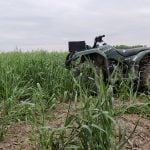Initially, at the start of a growing season, an irrigation manager wants to ensure adequate water is available for crop germination. Sometimes, light, frequent water applications are needed to ensure excellent, uniform germination, emergence, stand establishment and early crop growth.
This is possible with low pressure pivot irrigation systems, which apply rates as low as six to eight millimetres of water with a quarter section pivot in a 24-hour period. When applying water to initiate germination, great care is needed to ensure the soil surface remains moist and the soil does not form a hard, impenetrable crust, which could reduce the emergence of a germinating crop.
Most farmers typically have quarter section pivots that put out about 800 to 900 U.S. gallons per minute. If a pivot that puts out 900 U.S. gallons per minute makes a full circle in 24 hours, the gross water applied is 9.1 millimetres and the net application is 7.7 millimetres, assuming 85 per cent efficiency (see Tables 1 and 2 below).


Wheat has an average peak water use in the range of seven millimetres of water per day. But peak water use for wheat at the heading growth stage to the grain filling stage can be up to 10 millimetres of water per day when daily temperatures are more than 30 C and the conditions are windy.
In mid-summer, when prolonged hot weather occurs, a system that puts out 900 U.S. gallons per minute may not be able to keep up with daily crop water use. If a pivot system cannot keep up with peak water use requirements, growth and yield may suffer.
Read Also

Gentle treatments for pain in the neck
Heading toward year-end, people unknowingly tense up against the cold and busyness, causing neck pain that can often be treated with appropriate support and gentle mobility, athletic therapist Kathlyn Hossack says.
It is important to note that assuming low pressure pivots are always 80 to 85 per cent efficient is very simplistic. The operating speed can make a huge difference in efficiency. The percentage of water lost due to evaporation from the spray and evaporation from the soil and crop canopy is increased as the time to make a circle is decreased.
For example, in Table 3 (below), a quarter section centre pivot with a gross water application of 900 U.S. gallons per minute with an assumed water loss of four millimetres per application results in an application efficiency of 56 per cent when the pivot speed to make a full circle is one day. If the pivot speed is reduced to make a full circle in two or three days, the efficiency is improved to 76 and 85 per cent, respectively.

It is important to run pivots more slowly to reduce evaporation losses and for best water application efficiency, but quickly enough to minimize water ponding and surface runoff losses. It is important to note, when planning irrigation an irrigator must remember if it takes three days to make a full circle, the last part of the field irrigated will be drier than the part of the field where irrigation was started.
To effectively manage pivot irrigation systems, a good understanding of the net water application for each pivot system on the farm is crucial. It is important to know how much water is being stored in the soil. Then, monitor your soil water content frequently to do your best to match water application with daily crop water use for best irrigation management.
MEASURING SOIL MOISTURE
The ability to measure soil moisture rapidly and accurately is critical for irrigation management. Knowing the soil moisture level relative to field capacity and permanent wilting point is necessary to determine the amount of water in soil. There are several different tools that can be used to measure soil moisture.
The simplest, easiest and least expensive way to measure soil moisture is with the hand-feel method. This procedure uses a Dutch soil auger to take soil samples from specific depths in the effective root zone and feel the soil to estimate the soil water content. Different soil textures have a unique feel with specific characteristics relative to the soil water content. With experience, a farmer can reasonably estimate a soil’s moisture content. As mentioned in previous articles, the United States Department of Agriculture has excellent information on using the hand-feel method to estimate soil moisture.
Various types of soil moisture sensors are available that can be installed in soil to provide moisture content on a real-time basis. Sensors can be electronically linked to advise a grower of soil moisture conditions without having to be present in the field. Some sensors require careful calibration, and the systems are not always user friendly.
There is also evapotranspiration (ET)-based irrigation management methods to assist with determining when to irrigate. These are sometimes referred to as weather-based methods. The approach to these methods is to maintain a running balance of current soil moisture available to the plant by tracking the ET losses and the additions from irrigation and precipitation. This is similar to maintaining the balance in a chequing account and is referred to as the “cheque book” method of irrigation scheduling.
Alberta has a network of weather stations referred to as the Irrigation Management Climate Information Network (IMCIN) that collects data used for estimating ET-based irrigation management.
Crop water requirements are estimated by a web-based calculator available at the IMCIN website and by the Alberta Irrigation Management Model (AIMM). The AIMM program is an irrigation scheduling decision-support system that uses data from the nearest meteorological station to assist in on-farm irrigation scheduling operations and can be downloaded from the Alberta Agriculture website. The IMCIN calculator, known as IRRI-Cast, and the AIMM use the modified Penman-Monteith equation to estimate ET. This ET function assumes ideal crop-growing conditions. If ideal conditions do not exist, overestimation of crop water use may result.
The AIMM software is unique in that it is capable of forecasting crop water requirements and tracking available soil water throughout the growing season in the irrigated areas of southern Alberta. The AIMM model is a detailed software program that is specific to individual fields.
A unique feature of the AIMM program is that it has been combined with center pivot communication and control technologies to enable an irrigator to effectively manage irrigation on many fields to save time, energy and labour. The AIMM program also has the capability of keeping records on irrigation water applied, pump specifications and operations, weather data and other field records.
AN EXAMPLE OF PIVOT MANAGEMENT
If we use wheat as an example crop, the effective rooting depth is 100 centimetres under favourable soil conditions. Table 4 (below) shows an example of a soil profile to 100 centimetres with loam-textured soil in the surface to 50 centimetres and clay loam soil from a depth of 50 to 100 centimetres. Table 4 shows the amount of total soil moisture to 100 centimetres and the readily available moisture, assuming the safe depletion is 40 per cent of the total moisture for each soil depth. In this example, the total readily available water in 100 centimetres is 86 millimetres of water. However, about 70 per cent of wheat water requirements is taken up from the top 50-centimetre root zone.

An effective irrigation management strategy is to maintain soil moisture in the top 50 centimetres between field capacity and 60 per cent of available water.
In the example in Table 4, there are only 18 millimetres of readily available water in each of the zero- to 25-centimetre depths and 25- to 50-centimetre depths, for a total of 36 millimetres per 50 centimetres of soil.
When the soil is at field capacity, there is only 36 millimetres of readily available water. As the readily available water is being used by wheat, it must be replaced to ensure optimum yield potential. If wheat is using seven millimetres of water per day, it would take five days to use up the readily available water. However, if the weather conditions are very hot and windy, wheat could use nine millimetres of water per day, and it would take only four days to use up the readily available water. Thus, crop water use and soil moisture levels must be carefully observed to ensure irrigation water is applied at the right time to keep soil moisture above a safe depletion point.
CHECK SOIL MOISTURE FREQUENTLY
To maintain moisture between field capacity and the safe depletion point, checking soil moisture frequently is critical. If this is done successfully during the growing season, an optimum crop yield can be achieved. Various tools are available to farmers to assist with water management. Tap into these resources to assist with optimizing your irrigation management.
Good luck to all irrigation farmers for a successful growing season.
















